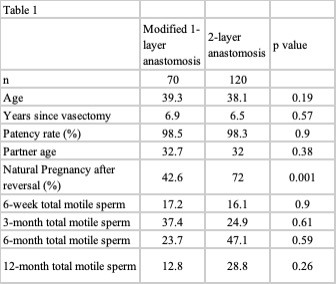Back
Poster, Podium & Video Sessions
Moderated Poster
MP34: Infertility: Therapy
MP34-08: Two-Layer Vasovasotomy Technique is Associated with Improved Pregnancy Rates as Compared to Modified One-Layer Technique
Saturday, May 14, 2022
4:30 PM – 5:45 PM
Location: Room 225
Matt Kasson*, Ashley Pittman, David Charles, Jacqueline Sehring, Peter Dietrich, Jay Sandlow, Milwaukee, WI
- MK
Matthew J. Kasson, MD, BS
Medical College of Wisconsin
Poster Presenter(s)
Introduction: Vasectomy reversal has evolved since the advent of the microscope in 1970. There has been conflicting data on superiority of 1-layer versus 2-layer anastomosis techniques. However, there are few studies comparing pregnancy rates. This study sought to evaluate the semen parameters, patency, and natural pregnancy rates of modified one-layer vs two-layer vasovasostomy.
Methods: A retrospective review of all patients undergoing vasovasostomy by a single surgeon from 2008-2021 was performed. Patients were included if they had a bilateral 2-layer anastomosis or a bilateral 1-layer anastomosis and a follow up semen analysis. Years from vasectomy, partner age, semen parameters, and confirmed biochemical pregnancy was recorded. Patients pregnant after in vitro fertilization (IVF) were noted but not included in the pregnancy analysis. Statistical analysis was performed using STATA, with a p<0.05 considered significant.
Results: 190 patients were included in the study. 70 patients had a modified 1-layer anastomosis and 120 had a 2-layer anastomosis, with a mean age of 39.3 and 38.1 years, respectively. The average years from vasectomy to reversal, patency rate, and partner age, and post-reversal semen parameters were all similar between groups (Table 1). A logistic regression for pregnancy rate using partner age, years from vasectomy, and type of anastomosis showed that a 2-layer anastomosis was 3.5 times as likely to result in pregnancy (p=0.003), with partner age and years since vasectomy negatively correlating with pregnancy but not significant (OR 0.93 and 0.97, respectively). IVF after reversal was done in 3 couples with modified 1-layer and 8 couples with 2-layer anastomoses.
Conclusions: Vasovasostomy using a 2-layer anastomotic technique resulted in a significantly increased rate of pregnancy as compared to a modified 1-layer technique.
Source of Funding: None

Methods: A retrospective review of all patients undergoing vasovasostomy by a single surgeon from 2008-2021 was performed. Patients were included if they had a bilateral 2-layer anastomosis or a bilateral 1-layer anastomosis and a follow up semen analysis. Years from vasectomy, partner age, semen parameters, and confirmed biochemical pregnancy was recorded. Patients pregnant after in vitro fertilization (IVF) were noted but not included in the pregnancy analysis. Statistical analysis was performed using STATA, with a p<0.05 considered significant.
Results: 190 patients were included in the study. 70 patients had a modified 1-layer anastomosis and 120 had a 2-layer anastomosis, with a mean age of 39.3 and 38.1 years, respectively. The average years from vasectomy to reversal, patency rate, and partner age, and post-reversal semen parameters were all similar between groups (Table 1). A logistic regression for pregnancy rate using partner age, years from vasectomy, and type of anastomosis showed that a 2-layer anastomosis was 3.5 times as likely to result in pregnancy (p=0.003), with partner age and years since vasectomy negatively correlating with pregnancy but not significant (OR 0.93 and 0.97, respectively). IVF after reversal was done in 3 couples with modified 1-layer and 8 couples with 2-layer anastomoses.
Conclusions: Vasovasostomy using a 2-layer anastomotic technique resulted in a significantly increased rate of pregnancy as compared to a modified 1-layer technique.
Source of Funding: None


.jpg)
.jpg)